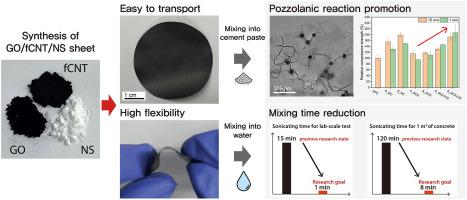A novel strategy utilizing graphene oxide/functionalized carbon nanotube/nanosilica sheet for nanomaterial incorporation in cement paste
IF 10.8
1区 工程技术
Q1 CONSTRUCTION & BUILDING TECHNOLOGY
引用次数: 0
Abstract
This study addresses the limitations of conventional methods in incorporating nanomaterials, including prolonged dispersion times and handling challenges in construction field applications, by developing graphene oxide/functionalized carbon nanotube/nanosilica (GCS) sheets. The GCS sheet, as a portable sheet form of a nanomaterial composite, achieves high nanomaterial dispersibility with only 1 min of sonication. The dispersion efficiency of the GCS sheets was evaluated using UV–vis spectroscopy, zeta potential measurements, and transmission electron microscopy, and the impact on material properties was assessed using compressive strength tests. The hydration processes were investigated using X-ray diffraction and 29Si nuclear magnetic resonance, and the nanomaterial dispersion within the cement matrix was studied using synchrotron X-ray nanoimaging. The GCS sheet facilitated more effective nanosilica dispersion on the graphene oxide plane compared to the powder form, achieving optimal dispersion in 1 min. This resulted in enhanced compressive strength, increased polymerization of calcium silicate hydrates, and a more elongated pore structure owing to the reduced aggregation of the GCS composites.


利用氧化石墨烯/功能化碳纳米管/纳米二氧化硅片在水泥浆中掺入纳米材料的新策略
本研究通过开发氧化石墨烯/功能化碳纳米管/纳米二氧化硅(GCS)片,解决了传统方法在结合纳米材料方面的局限性,包括延长分散时间和处理建筑领域应用中的挑战。GCS片材作为纳米材料复合材料的一种便携式片材形式,只需1分钟的超声即可实现高纳米材料的分散性。采用紫外-可见光谱、zeta电位测量和透射电子显微镜评估了GCS片材的分散效率,并通过抗压强度测试评估了对材料性能的影响。利用x射线衍射和29Si核磁共振研究了水化过程,利用同步加速器x射线纳米成像研究了纳米材料在水泥基体中的分散。与粉末形式相比,GCS薄片更有效地促进了纳米二氧化硅在氧化石墨烯平面上的分散,在1分钟内实现了最佳分散。这导致抗压强度增强,硅酸钙水合物的聚合增加,并且由于GCS复合材料的聚集减少,孔隙结构更长。
本文章由计算机程序翻译,如有差异,请以英文原文为准。
求助全文
约1分钟内获得全文
求助全文
来源期刊

Cement & concrete composites
工程技术-材料科学:复合
CiteScore
18.70
自引率
11.40%
发文量
459
审稿时长
65 days
期刊介绍:
Cement & concrete composites focuses on advancements in cement-concrete composite technology and the production, use, and performance of cement-based construction materials. It covers a wide range of materials, including fiber-reinforced composites, polymer composites, ferrocement, and those incorporating special aggregates or waste materials. Major themes include microstructure, material properties, testing, durability, mechanics, modeling, design, fabrication, and practical applications. The journal welcomes papers on structural behavior, field studies, repair and maintenance, serviceability, and sustainability. It aims to enhance understanding, provide a platform for unconventional materials, promote low-cost energy-saving materials, and bridge the gap between materials science, engineering, and construction. Special issues on emerging topics are also published to encourage collaboration between materials scientists, engineers, designers, and fabricators.
 求助内容:
求助内容: 应助结果提醒方式:
应助结果提醒方式:


